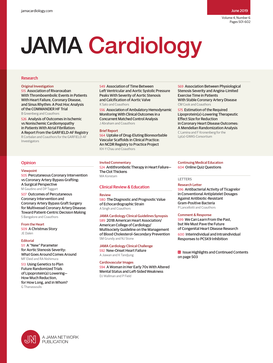Iodinated Adhesive Drapes for Repeat Cardiac Implantable Device Implantation
IF 14.1
1区 医学
Q1 CARDIAC & CARDIOVASCULAR SYSTEMS
引用次数: 0
Abstract
ImportanceOne potential pathophysiological mechanism for cardiac implantable electronic device (CIED) infections is pocket contamination during the implantation procedure. Preventing contamination at this stage may significantly reduce the risk of infections.ObjectiveTo determine whether the application of an intraoperative adhesive iodine-impregnated drape would reduce the rate of end-of-procedure pocket-swab positivity and subsequent CIED infections.Design, Setting, and ParticipantsThis was a prospective, double-armed, single-blinded, randomized clinical trial, conducted from November 2020 to May 2024. Patients, the staff performing the swabs, and the microbiologists were blinded to group assignments. This was a single-center study that included patients undergoing repeat procedures on the same device pocket. These patients were randomized in a 1:1 ratio to either the iodine-impregnated drape group or the control group.InterventionApplication of an iodine-impregnated drape at the beginning of the procedure.Main Outcomes and MeasuresThe primary end point was end-of-procedure pocket-swab culture positivity.ResultsA total of 418 patients were randomized (210 to the drape group and 208 to the no-drape group). The final analysis included 189 patients in the drape group and 195 patients in the no-drape group, with both groups well balanced in demographics. In the drape group, 143 participants were male (75.7%), and mean (SD) age was 73.9 (12.1) years; in the no-drape group, 140 were male (71.8%), and mean (SD) age was 73.2 (12.6) years. Pocket-swab culture positivity was found in 19 of 189 patients (10.1%) in the drape group compared with 40 of 195 patients (20.5%) in the no-drape group (relative risk reduction [RRR], 0.50; 95% CI, 0.24-0.75;用于心脏植入装置重复植入的碘化胶布
心脏植入式电子装置(CIED)感染的一个潜在病理生理机制是植入过程中的口袋污染。在这个阶段防止污染可能会大大降低感染的风险。目的探讨术中应用碘浸渍黏附纱布是否能降低术后口袋拭子阳性及继发CIED感染的发生率。设计、环境和参与者这是一项前瞻性、双臂、单盲、随机临床试验,于2020年11月至2024年5月进行。患者、进行拭子测试的工作人员和微生物学家对小组分配不知情。这是一项单中心研究,包括在同一设备口袋上进行重复手术的患者。这些患者按1:1的比例随机分为碘浸渍布组或对照组。干预措施:在手术开始时应用碘浸渍纱布。主要结果和测量主要终点为手术结束时口袋拭子培养阳性。结果共纳入418例患者,其中悬垂组210例,无悬垂组208例。最终的分析包括189名有窗帘组患者和195名无窗帘组患者,两组在人口统计学上都很平衡。在窗帘组中,143名参与者为男性(75.7%),平均(SD)年龄为73.9(12.1)岁;无遮挡组男性140例(71.8%),平均(SD)年龄73.2(12.6)岁。悬垂组189例患者中有19例(10.1%)出现口袋拭子培养阳性,而无悬垂组195例患者中有40例(20.5%)出现口袋拭子培养阳性(相对风险降低[RRR], 0.50; 95% CI, 0.24-0.75; P = 0.005)。无遮盖组195例患者中有4例(1.9%)确诊为CIED感染,而有遮盖组189例患者中有0例(P = 0.02)。59例拭子阳性患者中有2例(3.4%)发生CIED感染,325例拭子阴性患者中有2例(0.6%)发生CIED感染(优势比5.67;95% CI, 0.78 ~ 41.04; P = 0.08)。结论和相关性在这项随机临床试验中,在重复CIED植入期间使用碘浸渍纱布可降低拭子培养阳性和1年CIED感染率。这是一种简单且经济有效的干预措施,可减少CIED口袋污染和随后的感染。临床试验注册号:NCT04591366
本文章由计算机程序翻译,如有差异,请以英文原文为准。
求助全文
约1分钟内获得全文
求助全文
来源期刊

JAMA cardiology
Medicine-Cardiology and Cardiovascular Medicine
CiteScore
45.80
自引率
1.70%
发文量
264
期刊介绍:
JAMA Cardiology, an international peer-reviewed journal, serves as the premier publication for clinical investigators, clinicians, and trainees in cardiovascular medicine worldwide. As a member of the JAMA Network, it aligns with a consortium of peer-reviewed general medical and specialty publications.
Published online weekly, every Wednesday, and in 12 print/online issues annually, JAMA Cardiology attracts over 4.3 million annual article views and downloads. Research articles become freely accessible online 12 months post-publication without any author fees. Moreover, the online version is readily accessible to institutions in developing countries through the World Health Organization's HINARI program.
Positioned at the intersection of clinical investigation, actionable clinical science, and clinical practice, JAMA Cardiology prioritizes traditional and evolving cardiovascular medicine, alongside evidence-based health policy. It places particular emphasis on health equity, especially when grounded in original science, as a top editorial priority.
 求助内容:
求助内容: 应助结果提醒方式:
应助结果提醒方式:


